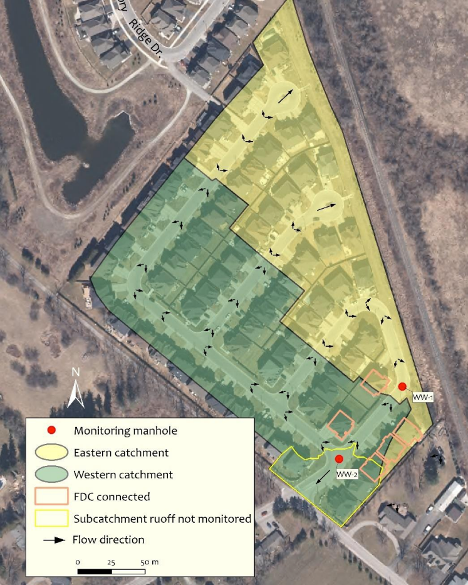Understanding and Assessing Impacts
Historical climate data from Person International Airport was used to compare the historical records of the number and type of events collected at our climate station near Wychwood over the two-year monitoring period. The purpose is to determine if the events collected represent historical norms across the region. Understanding the relative contributions of events of different sizes to annual rainfall is important for interpreting performance results.
Stormwater management practices such as wet detention ponds have been in place for more than 30 years. A study conducted by the Lake Simcoe Region Conservation Authority (LSRCA) surveyed ponds ranging in age from two to 23 years. Of the 98 ponds surveyed, 77 were designed to meet Level 1 criteria (the most stringent type of quality control with 80% phosphorus reduction). Only 36 ponds (less than half) were still operating at Level 1 efficiency.
As of 2018, there were 180 ponds within the City of Brampton stormwater infrastructure inventory and estimates suggest that approximately 400 ponds will exist at build out when Brampton has reached its municipal development boundaries. Preventative and corrective maintenance costs for stormwater ponds can vary depending on the work required. Ongoing pond inspection is the most common maintenance cost accrued and can cost anywhere between $713 and $1425 per inspection depending on staff salary. Once a stormwater pond reaches its full sediment load, the settled material must be removed and disposed of to maintain the pond’s sediment removal design storage. Sediment removal and disposal costs range from $53 to $513 per cubic metre of sediment removed.
In addition to budget implications, there is evidence that stormwater ponds are not completely alleviating peak flows from urban areas at the watershed scale. Furthermore, stormwater ponds do not control the volume of water discharged to receiving streams; rather, ponds delay the discharge of stormwater flows. Streamflow data from Brampton indicates that while stormwater ponds do reduce peak flow from individual ponds to receiving streams, the cumulative impact can still result in peak flows that are up to two orders of magnitude higher than pre-development peak flow conditions, despite the use of ponds.
The addition of sustained funding from a stormwater charge in Brampton’s municipal budget will help maintain stormwater assets in the near term, however, based on studies from LSRCA and CVC, funding gaps will remain if stormwater ponds continue to be the preferred method of managing stormwater.
